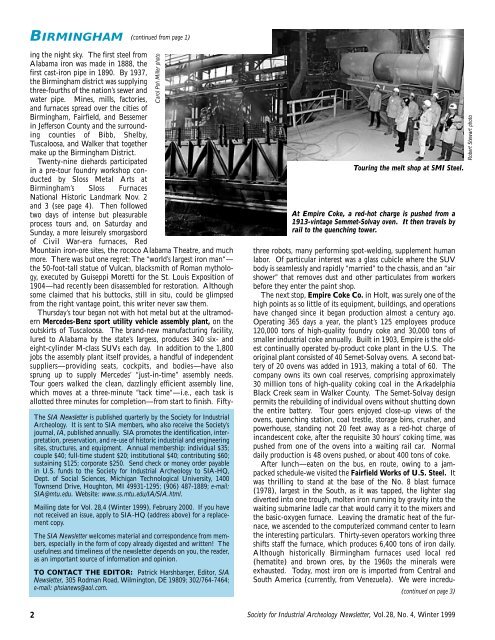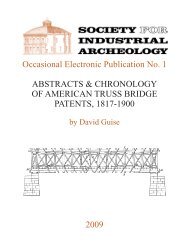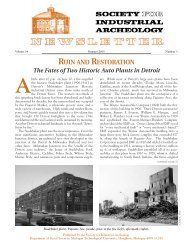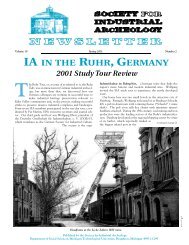birmingham, “pittsburgh of the south,” - Society for Industrial ...
birmingham, “pittsburgh of the south,” - Society for Industrial ...
birmingham, “pittsburgh of the south,” - Society for Industrial ...
Create successful ePaper yourself
Turn your PDF publications into a flip-book with our unique Google optimized e-Paper software.
BIRMINGHAM (continued from page 1)<br />
ing <strong>the</strong> night sky. The first steel from<br />
Alabama iron was made in 1888, <strong>the</strong><br />
first cast-iron pipe in 1890. By 1937,<br />
<strong>the</strong> Birmingham district was supplying<br />
three-fourths <strong>of</strong> <strong>the</strong> nation’s sewer and<br />
water pipe. Mines, mills, factories,<br />
and furnaces spread over <strong>the</strong> cities <strong>of</strong><br />
Birmingham, Fairfield, and Bessemer<br />
in Jefferson County and <strong>the</strong> surrounding<br />
counties <strong>of</strong> Bibb, Shelby,<br />
Tuscaloosa, and Walker that toge<strong>the</strong>r<br />
make up <strong>the</strong> Birmingham District.<br />
Twenty-nine diehards participated<br />
in a pre-tour foundry workshop conducted<br />
by Sloss Metal Arts at<br />
Birmingham’s Sloss Furnaces<br />
National Historic Landmark Nov. 2<br />
and 3 (see page 4). Then followed<br />
two days <strong>of</strong> intense but pleasurable<br />
process tours and, on Saturday and<br />
Sunday, a more leisurely smorgasbord<br />
<strong>of</strong> Civil War-era furnaces, Red<br />
Mountain iron-ore sites, <strong>the</strong> rococo Alabama Theatre, and much<br />
more. There was but one regret: The “world’s largest iron man“—<br />
<strong>the</strong> 50-foot-tall statue <strong>of</strong> Vulcan, blacksmith <strong>of</strong> Roman mythology,<br />
executed by Guiseppi Moretti <strong>for</strong> <strong>the</strong> St. Louis Exposition <strong>of</strong><br />
1904—had recently been disassembled <strong>for</strong> restoration. Although<br />
some claimed that his buttocks, still in situ, could be glimpsed<br />
from <strong>the</strong> right vantage point, this writer never saw <strong>the</strong>m.<br />
Thursday’s tour began not with hot metal but at <strong>the</strong> ultramodern<br />
Mercedes-Benz sport utility vehicle assembly plant, on <strong>the</strong><br />
outskirts <strong>of</strong> Tuscaloosa. The brand-new manufacturing facility,<br />
lured to Alabama by <strong>the</strong> state’s largess, produces 340 six- and<br />
eight-cylinder M-class SUVs each day. In addition to <strong>the</strong> 1,800<br />
jobs <strong>the</strong> assembly plant itself provides, a handful <strong>of</strong> independent<br />
suppliers—providing seats, cockpits, and bodies—have also<br />
sprung up to supply Mercedes’ “just-in-time<strong>”</strong> assembly needs.<br />
Tour goers walked <strong>the</strong> clean, dazzlingly efficient assembly line,<br />
which moves at a three-minute “tack time“—i.e., each task is<br />
allotted three minutes <strong>for</strong> completion—from start to finish. Fifty-<br />
The SIA Newsletter is published quarterly by <strong>the</strong> <strong>Society</strong> <strong>for</strong> <strong>Industrial</strong><br />
Archeology. It is sent to SIA members, who also receive <strong>the</strong> <strong>Society</strong>’s<br />
journal, IA, published annually. SIA promotes <strong>the</strong> identification, interpretation,<br />
preservation, and re-use <strong>of</strong> historic industrial and engineering<br />
sites, structures, and equipment. Annual membership: individual $35;<br />
couple $40; full-time student $20; institutional $40; contributing $60;<br />
sustaining $125; corporate $250. Send check or money order payable<br />
in U.S. funds to <strong>the</strong> <strong>Society</strong> <strong>for</strong> <strong>Industrial</strong> Archeology to SIA-HQ,<br />
Dept. <strong>of</strong> Social Sciences, Michigan Technological University, 1400<br />
Townsend Drive, Houghton, MI 49931-1295; (906) 487-1889; e-mail:<br />
SIA@mtu.edu. Website: www.ss.mtu.edu/IA/SIA.html.<br />
Mailing date <strong>for</strong> Vol. 28,4 (Winter 1999), February 2000. If you have<br />
not received an issue, apply to SIA-HQ (address above) <strong>for</strong> a replacement<br />
copy.<br />
The SIA Newsletter welcomes material and correspondence from members,<br />
especially in <strong>the</strong> <strong>for</strong>m <strong>of</strong> copy already digested and written! The<br />
usefulness and timeliness <strong>of</strong> <strong>the</strong> newsletter depends on you, <strong>the</strong> reader,<br />
as an important source <strong>of</strong> in<strong>for</strong>mation and opinion.<br />
TO CONTACT THE EDITOR: Patrick Harshbarger, Editor, SIA<br />
Newsletter, 305 Rodman Road, Wilmington, DE 19809; 302/764-7464;<br />
e-mail: phsianews@aol.com.<br />
Carol Poh Miller photo<br />
Touring <strong>the</strong> melt shop at SMI Steel.<br />
At Empire Coke, a red-hot charge is pushed from a<br />
1913-vintage Semmet-Solvay oven. It <strong>the</strong>n travels by<br />
rail to <strong>the</strong> quenching tower.<br />
three robots, many per<strong>for</strong>ming spot-welding, supplement human<br />
labor. Of particular interest was a glass cubicle where <strong>the</strong> SUV<br />
body is seamlessly and rapidly “married<strong>”</strong> to <strong>the</strong> chassis, and an “air<br />
shower<strong>”</strong> that removes dust and o<strong>the</strong>r particulates from workers<br />
be<strong>for</strong>e <strong>the</strong>y enter <strong>the</strong> paint shop.<br />
The next stop, Empire Coke Co. in Holt, was surely one <strong>of</strong> <strong>the</strong><br />
high points as so little <strong>of</strong> its equipment, buildings, and operations<br />
have changed since it began production almost a century ago.<br />
Operating 365 days a year, <strong>the</strong> plant’s 125 employees produce<br />
120,000 tons <strong>of</strong> high-quality foundry coke and 30,000 tons <strong>of</strong><br />
smaller industrial coke annually. Built in 1903, Empire is <strong>the</strong> oldest<br />
continually operated by-product coke plant in <strong>the</strong> U.S. The<br />
original plant consisted <strong>of</strong> 40 Semet-Solvay ovens. A second battery<br />
<strong>of</strong> 20 ovens was added in 1913, making a total <strong>of</strong> 60. The<br />
company owns its own coal reserves, comprising approximately<br />
30 million tons <strong>of</strong> high-quality coking coal in <strong>the</strong> Arkadelphia<br />
Black Creek seam in Walker County. The Semet-Solvay design<br />
permits <strong>the</strong> rebuilding <strong>of</strong> individual ovens without shutting down<br />
<strong>the</strong> entire battery. Tour goers enjoyed close-up views <strong>of</strong> <strong>the</strong><br />
ovens, quenching station, coal trestle, storage bins, crusher, and<br />
powerhouse, standing not 20 feet away as a red-hot charge <strong>of</strong><br />
incandescent coke, after <strong>the</strong> requisite 30 hours’ coking time, was<br />
pushed from one <strong>of</strong> <strong>the</strong> ovens into a waiting rail car. Normal<br />
daily production is 48 ovens pushed, or about 400 tons <strong>of</strong> coke.<br />
After lunch—eaten on <strong>the</strong> bus, en route, owing to a jampacked<br />
schedule-we visited <strong>the</strong> Fairfield Works <strong>of</strong> U.S. Steel. It<br />
was thrilling to stand at <strong>the</strong> base <strong>of</strong> <strong>the</strong> No. 8 blast furnace<br />
(1978), largest in <strong>the</strong> South, as it was tapped, <strong>the</strong> lighter slag<br />
diverted into one trough, molten iron running by gravity into <strong>the</strong><br />
waiting submarine ladle car that would carry it to <strong>the</strong> mixers and<br />
<strong>the</strong> basic-oxygen furnace. Leaving <strong>the</strong> dramatic heat <strong>of</strong> <strong>the</strong> furnace,<br />
we ascended to <strong>the</strong> computerized command center to learn<br />
<strong>the</strong> interesting particulars. Thirty-seven operators working three<br />
shifts staff <strong>the</strong> furnace, which produces 6,400 tons <strong>of</strong> iron daily.<br />
Although historically Birmingham furnaces used local red<br />
(hematite) and brown ores, by <strong>the</strong> 1960s <strong>the</strong> minerals were<br />
exhausted. Today, most iron ore is imported from Central and<br />
South America (currently, from Venezuela). We were incredu-<br />
(continued on page 3)<br />
2 <strong>Society</strong> <strong>for</strong> <strong>Industrial</strong> Archeology Newsletter, Vol.28, No. 4, Winter 1999<br />
Robert Stewart photo






